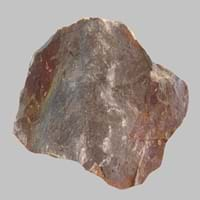Lignite and Hawaiite
Definition
Definition
Lignite is a soft brownish coal which shows traces of plants and is intermediate between bituminous coal and peat
Hawaiite is volcanic rock that resembles basalt. It is an olivine basalt with intermediate composition between alkali olivine and mugearite
History
Origin
France
Hawaii Islands
Discoverer
Unknown
Joseph Iddings
Etymology
From French, Latin lignum wood + -ite1
From Hawaii Islands
Class
Sedimentary Rocks
Igneous Rocks
Sub-Class
Durable Rock, Soft Rock
Durable Rock, Medium Hardness Rock
Family
Group
Not Applicable
Volcanic
Other Categories
Coarse Grained Rock, Fine Grained Rock, Medium Grained Rock, Opaque Rock
Opaque Rock
Texture
Texture
Amorphous, Glassy
Glassy, Massive, Porphyritic, Scoriaceous, Vesicular
Color
Black, Brown, Dark Brown, Grey, Light to Dark Grey
Black, Brown, Light to Dark Grey
Maintenance
Less
Less
Durability
Durable
Durable
Water Resistant
No
Yes
Scratch Resistant
No
Yes
Stain Resistant
No
No
Wind Resistant
No
Yes
Acid Resistant
No
No
Appearance
Veined or Pebbled
Dull and Soft
Uses
Architecture
Interior Uses
Not Yet Used
Decorative Aggregates, Floor Tiles, Flooring, Homes, Hotels, Interior Decoration, Kitchens
Exterior Uses
Not Yet Used
As Building Stone, As Facing Stone, Paving Stone, Garden Decoration, Office Buildings
Other Architectural Uses
Not Yet Used
Curbing
Industry
Construction Industry
for Road Aggregate, Steel Production
As Dimension Stone, Cobblestones, Rail Track Ballast, Roadstone
Medical Industry
Not Yet Used
Not Yet Used
Antiquity Uses
Not Yet Used
Artifacts
Other Uses
Commercial Uses
Electricity Generation
Creating Artwork, Sea Defence
Types
Types
Xyloid Lignite or Fossil Wood and Compact Lignite or Perfect Lignite
Not Available
Features
Generally rough to touch, Helps in production of Heat and Electricity, Used as fossil fuel
Has High structural resistance against erosion and climate, Very fine grained rock
Archaeological Significance
Monuments
Not Yet Used
Used
Famous Monuments
Not Applicable
Easter Island in the Polynesian Triangle, Pacific Ocean
Sculpture
Not Yet Used
Not Yet Used
Famous Sculptures
Not Applicable
Not Applicable
Pictographs
Used
Used
Petroglyphs
Used
Used
Figurines
Not Yet Used
Not Yet Used
Fossils
Present
Absent
Formation
Formation
Coal formation takes place due to accumulation of plant debris in a swamp environment. The Coal formation process continues, as peat turns into lignite brown or black coal at increasing heat and pressure.
Hawaiite is a fine-grained, hard rock that forms when bits of lava shoot out of volcanoes and reach the Earth's surface.
Composition
Mineral Content
Not Available
Olivine, Plagioclase, Pyroxene
Compound Content
Carbon, Hydrogen, Nitrogen, Oxygen, Sulphur
Aluminium Oxide, CaO, Iron(III) Oxide, FeO, Potassium Oxide, MgO, MnO, Sodium Oxide, Phosphorus Pentoxide, Silicon Dioxide, Titanium Dioxide
Transformation
Metamorphism
No
Yes
Types of Metamorphism
Not Applicable
Impact Metamorphism
Weathering
Yes
Yes
Types of Weathering
Biological Weathering, Chemical Weathering, Mechanical Weathering
Biological Weathering
Erosion
Yes
No
Types of Erosion
Chemical Erosion, Water Erosion, Wind Erosion
Not Applicable
Properties
Physical Properties
Hardness
1
6
Grain Size
Medium to Fine Coarse Grained
Not Applicable
Fracture
Conchoidal
Conchoidal
Streak
Black
Not Available
Porosity
Highly Porous
Less Porous
Luster
Dull to Vitreous to Submetallic
Not Available
Compressive Strength
Not Available
37.40 N/mm2
28
Cleavage
Non-Existent
Not Applicable
Toughness
Not Available
Not Available
Specific Gravity
1.1-1.4
Not Available
Transparency
Opaque
Opaque
Density
800-801 g/cm3
Not Available
Thermal Properties
Specific Heat Capacity
1.26 kJ/Kg K
5
Not Available
Resistance
Heat Resistant
Heat Resistant, Pressure Resistant, Wear Resistant
Reserves
Deposits in Eastern Continents
Asia
Bangladesh, Burma, Cambodia, China, India, Indonesia, Kazakhstan, Malaysia, Mongolia, Pakistan, Turkey, Vietnam
India, Russia
Africa
Botswana, Kenya, Morocco, Mozambique, South Africa, Tanzania
South Africa
Europe
Belgium, Bulgaria, England, France, Germany, Greece, Hungary, Kosovo, Netherlands, Norway, Poland, Romania, Serbia, Slovakia, Slovenia, The Czech Republic, Ukraine, United Kingdom
Iceland
Others
Not Yet Found
Hawaii Islands
Deposits in Western Continents
North America
Canada, Mexico, USA
Canada, USA
South America
Brazil, Chile, Colombia, Venezuela
Brazil
Deposits in Oceania Continent
Australia
New South Wales, Queensland, Victoria
Not Yet Found
All about Lignite and Hawaiite Properties
Know all about Lignite and Hawaiite properties here. All properties of rocks are important as they define the type of rock and its application. Lignite belongs to Sedimentary Rocks while Hawaiite belongs to Igneous Rocks.Texture of Lignite is Amorphous, Glassy whereas that of Hawaiite is Glassy, Massive, Porphyritic, Scoriaceous, Vesicular. Lignite appears Veined or Pebbled and Hawaiite appears Dull and Soft. The luster of Lignite is dull to vitreous to submetallic while that of Hawaiite is not available. Lignite and Hawaiite are available in black, brown, dark brown, grey, light to dark grey colors. The commercial uses of Lignite are electricity generation and that of Hawaiite are creating artwork, sea defence.
|
||
|
||
|










